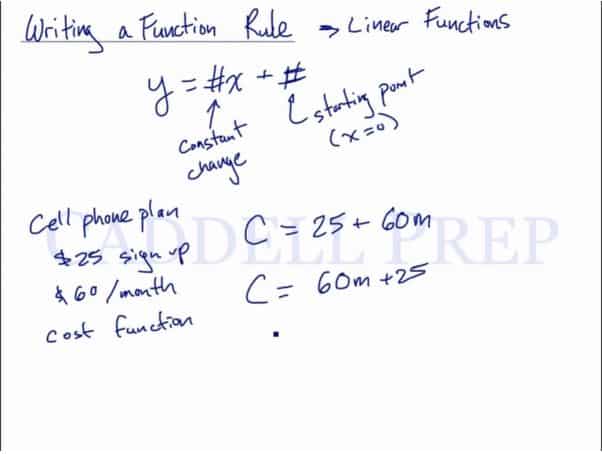This lesson is how to write a function rule. This video shows how functions typically behave, and how to write them down. Functions usually have a variable with a coefficient in front that represents the rate of change and has a constant value that represents the starting point of the function. After you finish this lesson, view all of our Algebra 1 lessons and practice problems.
The setup for this would look like:
Where # represents a constant
the constant rate of change
the starting point, x = 0
Examples of Writing a Function Rule
Example 1
Jason goes to an amusement park where he pays admission and
per ride. What is the function of the cost?
The cost is times the number of rides plus
. This can be written as a function:
Example 1
Maya has an internet service that currently has a monthly access fee of and a connection fee of
per hour. Represent her monthly cost as a function of connection time.
The cost has two parts: the one-time fee of and the per-hour charge of
. So the total cost is the charge per hour
the number of hours
the flat fee
Video-Lesson Transcript
We’re going to cover how to write a function rule for particularly linear functions.
Linear function has a basic form:
Where the represents the constant rate of change
and is the starting point. The starting point is where
.
For example:
We have a cellphone plan that requests at sign up and requires
per month. What is the function of the cost?
It will be cost equals start-up fee plus
multiplied by the months.
So we’ll have
This relates very closely with the basic form of linear equation which is .
Let’s look at another example.
A bank account has in it. Every week,
is added to it. Write a function to represent the amount of money (m) in the bank account after (w) weeks.
The money will be equal to starting amount plus the amount you add to it times the number of weeks that passed.
After weeks, the amount of money you have is computed as:
Now, let’s see how much money you make after weeks.
So, we’ll substitute for
.
Here, our function can be rewritten as
which follows the basic linear equation form of .



